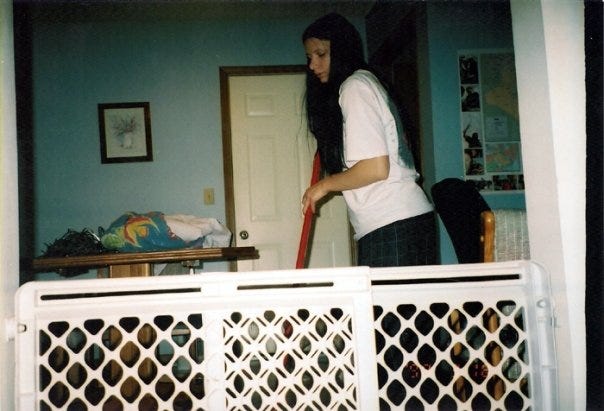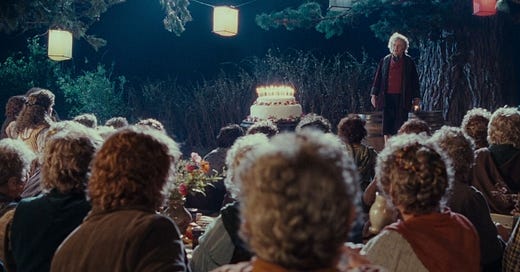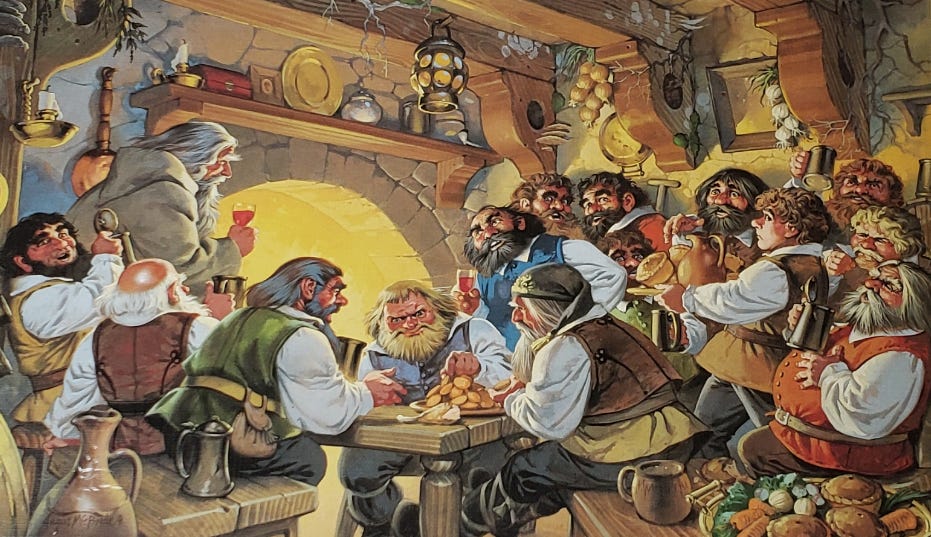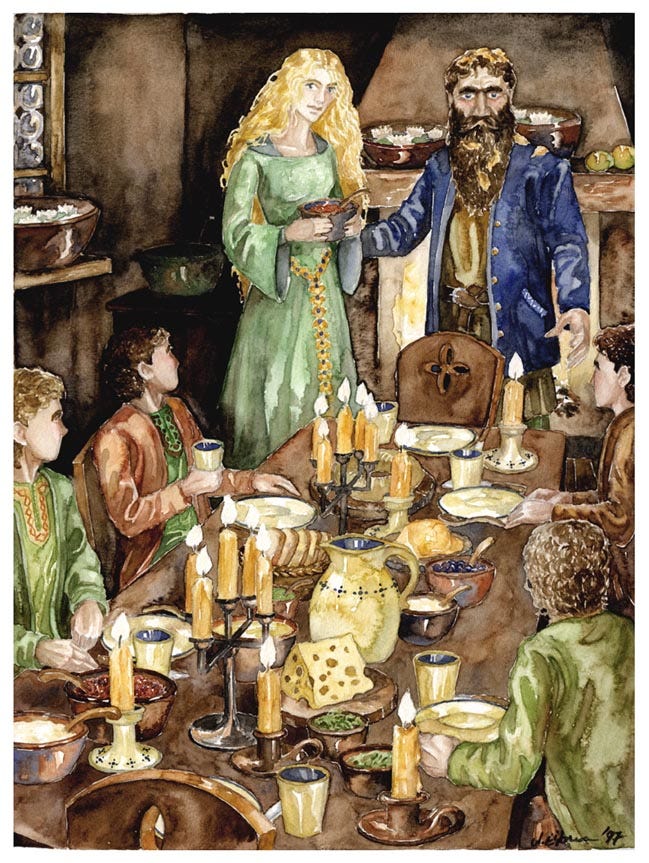Bilbo and Frodo happened to have the same birthday, September 22nd. ‘You had better come and live here, Frodo my lad,’ said Bilbo one day; ‘and then we can celebrate our birthday-parties comfortably together.’
- The Lord of the Rings, The Fellowship of the Ring, “A Long-Expected Party”
While most folks who follow a Tolkien blog are likely to be familiar with the custom of celebrating Hobbit Day, it does no harm to begin with an explanation that it is a day of merriment in honor of Bilbo and Frodo’s shared birthday. Of course, given the fact that the Shire Reckoning differs from the Gregorian calendar, September 22nd would actually correspond to September 13th. I have thus far refrained from being quite so pedantic in my approach to Hobbit Day, as most celebrations have generally occurred on our own September 22nd for decades now. Perhaps some year I will do it just for novelty’s sake; but it will not be this year.
My first Hobbit Day was technically not Hobbit Day at all. Rather, it was 2004, I was in my early 20s, and thrilled that the extended edition of The Return of the King would be available in December while I was home on winter break. Ever since the extended edition of The Fellowship of the Ring was released in November 2002, I had wanted to host a marathon of all three (speculated) extended editions. Of course, food would be needed for such an endeavor, and food was mentioned in plenty in the novel. What better way to host a watch party than to try to make some meals inspired by Middle-earth?
My memory of that time is becoming hazy. I am certain I didn’t plan a menu months in advance (as I do now). However, I keenly remember that I was inspired by The Council of Elrond, and their website section dedicated solely to recipes for the different cultures of Middle-earth. I attempted to roast a whole chicken with berries, which admittedly turned out to be rather strange and only partially edible. I concocted Entdraught made from some varieties of herbal tea. At the time, I thought it vitally important to try to light the glass vats of Entdraught from below with green and gold Christmas lights, as they produce such light in the book due to Treebeard's influence; but I can’t for the life of me recall what they actually tasted like. Bless my parents for making themselves scarce for the weekend so that I could do my best to realize this nerdy little dream of mine. It was imperfect, but it was the beginning of a long tradition that I have done my best to uphold whenever I have the ability to do so. And, of course, most of my Middle-earth feasting now takes place on or around September 22nd, rather than in December.

My skill has improved since then, by leaps and bounds. It must be mentioned here that I am strictly a home baker and cook. I have no professional training or education in this field, but as a very food-motivated little hobbit, I make it my business to continually learn and elevate my artistry in both baking and cooking. I have a passion for well-executed flavors and textures, and I take great pride in the fact that I have what I can only describe as a “mental map” of flavors that I can summon upon need or request to create or modify recipes.
Over the years, as my budget, skill, and living spaces have evolved, so too have my Hobbit Days. While I once only served food inspired by the simple lifestyles of hobbits, I now prefer to immerse my guests completely in the various cultures of Middle-earth by carefully crafting courses in line with both what is mentioned in the text, as well as what just feels right to me, given what we know of the agriculture (or lack thereof) and climate wherein those cultures exist. In recent years, the immersion concept has gone beyond food, to include additional features such as custom soundscapes that I create for the planned meal breaks, as well as a selection of candles and aromas to enhance the feeling that we are traveling through Middle-earth along with our heroes and villains. The candle that smells like dirt is particularly effective and well-received.
As mentioned, I draw from the text where possible when planning the menu, and the text is most generous in this regard with The Shire and the surrounding lands, such as Bree and the House of Tom Bombadil.
‘Come along in, and have some tea!’ he managed to say after taking a deep breath. ‘A little beer would suit me better, if it is all the same to you, my good sir,’ said Balin with the white beard. ‘But I don't mind some cake-seed-cake, if you have any.’
- The Hobbit, “An Unexpected Party”
‘Here’s my pretty lady!’ he said, bowing to the hobbits. ‘Here’s my Goldberry clothed all in silver-green with flowers in her girdle! Is the table laden? I see yellow cream and honeycomb, and white bread, and butter; milk, cheese, and green herbs and ripe berries gathered. Is that enough for us? Is the supper ready?’
- The Lord of the Rings, The Fellowship of the Ring, “In the House of Tom Bombadil”
In a twinkling the table was laid. There was hot soup, cold meats, a blackberry tart, new loaves, slabs of butter, and half a ripe cheese: good plain food, as good as the Shire could show, and homelike enough to dispel the last of Sam’s misgivings (already much relieved by the excellence of the beer).
- The Lord of the Rings, The Fellowship of the Ring, “At the Sign of the Prancing Pony”
Of course there are many more quotes about food that I could present for this region, but that should suffice for now.
We also have the food of Rivendell vaguely described as “very good” by Bilbo, Miruvor, the white mead and lembas of Lothlórien, salted pork at Isengard, and staples such as white cakes (likely a type of bread like Guildford Manchets) and apples in Minas Tirith.
After drawing from some of these basic descriptions of foods, I then improvise and embellish based upon what we know of the locales.
For example, I speculate that much of the food of Rivendell is foraged or hunted, and doubt that Elrond's folk practiced a robust agrarian culture; though I like to think that they would have had some modest kitchen gardens and perhaps a small orchard. This then inclines me to lean more toward using wild game and to incorporate foods that can be foraged when planning a Rivendell course. I can also infer some general aspects of Elven food culture based on the encounter between the hobbits and Gildor: fresh breads, fruits, and crisp wines. Simple, yet memorable flavors with a focus on high quality ingredients and precision baking.
It is also paramount to me to integrate spices and herbs that are more archaic, uncommon, or unusual into my recipes to enhance the sense that we are savoring the foods of another place and time. Some favorites of mine are long pepper, chervil, savory, sumac, juniper, nigella seeds, mace, fennel pollen, sorrel, verbena, borage, and other edible flowers. I also find that incorporating dairy from goats and sheep shifts the flavor profile in the direction that I desire.
I must implore you, though, to keep in mind that I am no food historian, and that I am in no way saying that all of the above flavors are rare in all cultures today. However, I do look on them as less common than they maybe once were, and a way to open the door into a culinary experience that just feels a bit otherworldly in a way that can be indefinable (in a good way).
However, I do take a slightly different approach when it comes to The Shire and Bree. We are already given much more concrete descriptions of the foods of these lands, so there is less speculation to be done on my part. In addition to this, The Shire and hobbit life is anachronistic (intentionally so), considering it is set in a far more ancient world but exhibits much of the fare that would only have been available in a later era due to colonization, if we are to approach Middle-earth as a sort of pre-history of our own world. Hobbits should not have tomatoes and potatoes, and yet they do. They are essentially living in a pastoral, Victorian bubble within an Age thousands of years long gone. This is how Tolkien wrote them, and he didn’t shy away from it after he decided that The Hobbit (and therefore The Lord of the Rings) would be set within the larger and more primordial world of Arda that he had been sub-creating for much of his life. Therefore, I enjoy leaning into this anachronism as well, with some caveats. Hobbits of The Shire have no love of boats, so I generally avoid including fish or seafood in their menu items, as I expect it would be uncommon. But rose water, a staple of Victorian baking before vanilla came into wide use, is absolutely fair game; and while sugar was certainly used in Victorian baking, I typically prefer to use honey instead, wherever possible.
These are all just some of the basic foundational concepts that I use to plan Hobbit Day: a starting point to generate ideas. Due to the very involved nature of my menu planning, soundscape creating, candle curating, and guest accommodating, it indeed takes months of careful thought and labor to bring those ideas to fruition in a way that minimizes the stress of throwing such an elaborate party.
If all of this sounds like a lot of work: it is! But it is a joy to me to put together a truly special treat for friends who also appreciate fine company, good food, and nerdy knowledge.
May you find happiness, amusement, and perhaps comfort or inspiration, as I share my journey to an immersive Hobbit Day experience.







